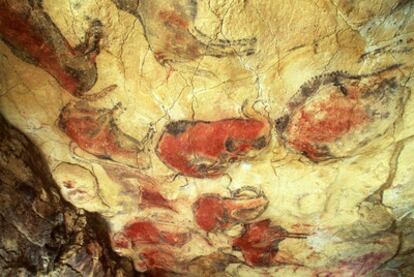The prehistoric art that won't be seen
Fears over damage to Paleolithic paintings will keep heritage site closed
After a range of expert advice was sought, it has finally been decided that the Altamira caves in the Cantabria region of northern Spain, home to Paleolithic paintings of herds of bison, bulls and other animals, will remain closed for the foreseeable future.
Earlier this year, the Culture Ministry announced that it wanted to reopen the caves - which were closed in 2002 due to concerns over damage to the paintings - to the public.
Discovered in 1879, amid a complex of subterranean caverns near the upmarket seaside resort of Santillana del Mar, the caves have been opened and closed to the public several times in their history. At first the cave paintings, believed to have been created around 14,000 years ago, were visited by a trickle of inquisitive locals, anthropologists and artists. On seeing them, Picasso famously proclaimed: "After Altamira, all is decadence."
"The caves have recovered but opening them again is not a good idea"
By the early 1970s, up to 170,000 people a year were trooping through the site. They were closed in 1977, when scientists discovered that the paintings in red, ochre and black were being damaged by carbon dioxide from the breath emanating from the huge numbers of visitors. The site was reopened in 1982, this time with strict visitor limits, leading to waiting lists of up to three years. In 1985, the caves were declared a World Heritage Site.
But it was decided to close them again in 2002, when green mold was discovered on some of the images.
Experts blame the deterioration on a change in the fragile atmosphere of the cave, caused by a combination of light, the body heat of visitors, and moisture from their breath.
An exact replica of the caves and its paintings has been created in a museum located a few hundred feet from the original. But pressure from the regional government, which sees the caves as a key tourist attraction, led Culture Minister Ángeles González-Sinde to go against the advice of the government's main scientific research body, the CSIC, and in August she announced that they would be reopening.
"Altamira is an asset we cannot do without," Cantabria regional premier, Miguel Ángel Revilla, said at the time, complaining that the replica cave was a poor imitation and that he had not even been allowed to show off the real thing to world leaders such as former French President Jacques Chirac. He added that he hoped Barack Obama would make a visit once they were opened.
"We have made it very clear that it should not be reopened at this time," said Sergio Sánchez Moral, director of the team that has spent two years analyzing the caves and treating the mould problem. "The caves have recovered from the damage, but opening them again is not a good idea. The risks are immeasurable," he added.

Tu suscripción se está usando en otro dispositivo
¿Quieres añadir otro usuario a tu suscripción?
Si continúas leyendo en este dispositivo, no se podrá leer en el otro.
FlechaTu suscripción se está usando en otro dispositivo y solo puedes acceder a EL PAÍS desde un dispositivo a la vez.
Si quieres compartir tu cuenta, cambia tu suscripción a la modalidad Premium, así podrás añadir otro usuario. Cada uno accederá con su propia cuenta de email, lo que os permitirá personalizar vuestra experiencia en EL PAÍS.
¿Tienes una suscripción de empresa? Accede aquí para contratar más cuentas.
En el caso de no saber quién está usando tu cuenta, te recomendamos cambiar tu contraseña aquí.
Si decides continuar compartiendo tu cuenta, este mensaje se mostrará en tu dispositivo y en el de la otra persona que está usando tu cuenta de forma indefinida, afectando a tu experiencia de lectura. Puedes consultar aquí los términos y condiciones de la suscripción digital.
Últimas noticias
Trump’s impact on International Migrants Day: ‘It has been one of the most difficult years, the cruelest’
Trump delivers address to the nation to exaggerate his achievements and blame Biden for the state of the economy
NASA discovers Titan doesn’t have an ocean, but a ‘slushy ice layer’ that increases possibility of life
Innocence lost in the forest of the child soldiers: ‘Each leader of the armed group had his girls’
Most viewed
- Christian Louboutin: ‘Young people don’t want to be like their parents. And if their parents wear sneakers, they’re going to look for something else’
- ‘El Limones’ and the growing union disguise of Mexican organized crime
- The low-cost creative revolution: How technology is making art accessible to everyone
- ‘We are dying’: Cuba sinks into a health crisis amid medicine shortages and misdiagnosis
- Liset Menéndez de la Prida, neuroscientist: ‘It’s not normal to constantly seek pleasure; it’s important to be bored, to be calm’








































